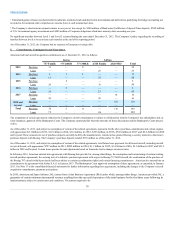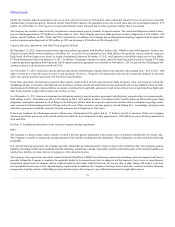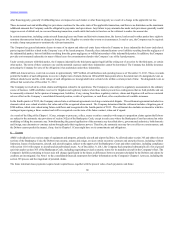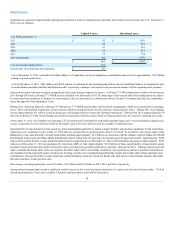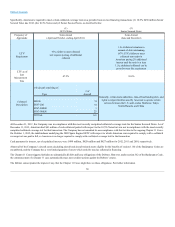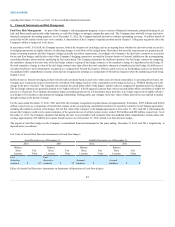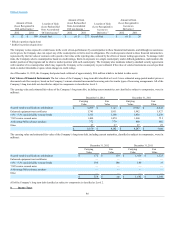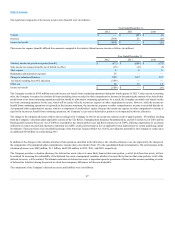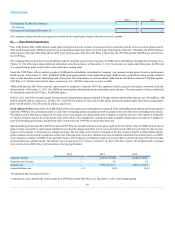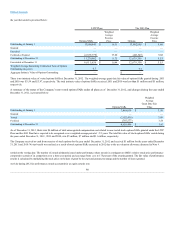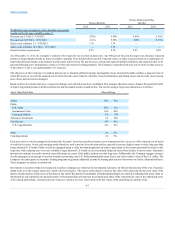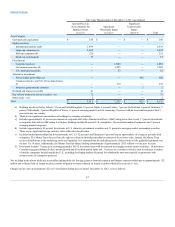American Airlines 2012 Annual Report Download - page 87
Download and view the complete annual report
Please find page 87 of the 2012 American Airlines annual report below. You can navigate through the pages in the report by either clicking on the pages listed below, or by using the keyword search tool below to find specific information within the annual report.
Table of Contents
The significant components of the income tax provision (benefit) were (in millions):
Year Ended December 31,
2012
2011
2010
Current
$ —
$ (25)
$ (5)
Deferred
(569)
25
(30)
Income tax benefit
$(569)
$ —
$(35)
The income tax expense (benefit) differed from amounts computed at the statutory federal income tax rate as follows (in millions):
Year Ended December 31,
2012
2011
2010
Statutory income tax provision expense/(benefit)
$(873)
$(686)
$(177)
State income tax expense/(benefit), net of federal tax effect
(35)
(32)
(2)
Meal expense
6
6
6
Bankruptcy administration expenses
26
—
—
Change in valuation allowance
858
697
127
Tax benefit resulting from OCI allocation
(569)
—
—
Other, net
18
15
11
Income tax benefit
$(569)
$ —
$(35)
The Company recorded a $569 million non-cash income tax benefit from continuing operations during the fourth quarter of 2012. Under current accounting
rules, the Company is required to consider all items (including items recorded in other comprehensive income) in determining the amount of tax benefit that
results from a loss from continuing operations and that should be allocated to continuing operations. As a result, the Company recorded a tax benefit on the
loss from continuing operations for the year, which will be exactly offset by income tax expense on other comprehensive income. However, while the income tax
benefit from continuing operations is reported on the income statement, the income tax expense on other comprehensive income is recorded directly to
Accumulated other comprehensive income, which is a component of stockholders’ equity. Because the income tax expense on other comprehensive income is
equal to the income tax benefit from continuing operations, the Company’s year-end net deferred tax position is not impacted by this tax allocation.
The change in the valuation allowance reflects the recording by the Company in 2010 of an income tax expense credit of approximately $30 million resulting
from the Company’s elections under applicable sections of the Tax Relief, Unemployment Insurance Reauthorization, and Job Creation Act of 2010 and the
Housing and Economic Recovery Act of 2008 (as extended by the American Recovery and Reinvestment Act of 2009), allowing corporations to accelerate
utilization of certain research and alternative minimum tax (AMT) credit carryforwards in lieu of applicable bonus depreciation on certain qualifying capital
investments. These provisions were extended by passage of the American Taxpayer Relief Act of 2012, providing the potential for the Company to realize up to
an additional $29 million in credits during 2013.
In addition to the changes in the valuation allowance from operations described in the table above, the valuation allowance was also impacted by the changes in
the components of Accumulated other comprehensive income (loss), described in Note 13 to the consolidated financial statements. The total increase in the
valuation allowance was $282 million, $1.1 billion, and $120 million in 2012, 2011, and 2010, respectively.
The Company provides a valuation allowance for deferred tax assets when it is more likely than not that some portion, or all of its deferred tax assets, will not
be realized. In assessing the realizability of the deferred tax assets, management considers whether it is more likely than not that some portion, or all of the
deferred tax assets, will be realized. The ultimate realization of deferred tax assets is dependent upon the generation of future taxable income (including reversals
of deferred tax liabilities) during the periods in which those temporary differences will become deductible.
The components of the Company's deferred tax assets and liabilities were (in millions):
87



